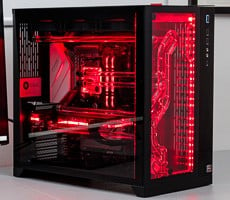Now that we’ve wrapped up the standard benchmark suites, we’ll take a look at how the system handled itself in game tests.
 |
Bioshock Infinite
|
DirectX 11 Gaming Performance
|
|
Based on Epic’s
Unreal Engine 3, BioShock Infinite takes you (as former Pinkerton agent Booker DeWitt) to the mysterious, flying city of Columbia. You find yourself helping Elizabeth, who soon turns out to have unusual powers. The game offers a first person shooter (FPS) style view but the storyline is as compelling as the battles and Bioshock Infinite has won awards and praise for its story and art design.
We are off to a very promising start for a game titles here. The Razer Blade has no issue maintaining sufficient frame rates to drive smooth performance at 1080p/60Hz. The minimum frame rates do dip significantly, but this is not uncommon for Bioshock and is the best result among GTX 1060 powered laptops we have tested.
 |
|
Shadow of Mordor |
| Glorious Orc-Slaying Vengeance
|
|
Monolith’s surprisingly fun Orc-slaying title Middle Earth: Shadow of Mordor, delivers a ton of visual fidelity even at the lowest quality settings. So, to maximize the eye-candy on this high-end laptop, we ran the game’s High quality benchmark routine at a couple of resolutions, topping out at the native resolution of the Razer Blade’s panel. All the game's graphics-related options were enabled, along with FXAA and Camera Blur...


The Razer Blade continues its strong showing in Shadow of Mordor with particularly strong performance at lower resolutions. Low resolution gaming is typically limited by the CPU's performance, while higher resolution gaming is more GPU bound. Given the falloff in performance relative to the competition here, we can surmise the GTX 1060 may be throttling a bit at 1080p, while the newer gen Kaby Lake i7 keeps performance strong under a lighter load at 900p and 720p. In any case, we are again well above 60fps at all resolutions so all your orc-slaying rampages will be beautifully rendered.
 |
|
Rise of the Tomb Raider |
|
DirectX 12 Performance
|
|
Rise of the Tomb Raider has hit the PC and landed in our gun sights for graphics, gameplay and performance analysis. The game launched on the
Xbox family of consoles first and has since been ported to PC thanks to NIXXES Software. It’s a competent console to PC port updated with many graphics settings and effects to tweak and dial to your particular tastes and system capabilities. Some of the rendering and effects features include, Ambient Occlusion, Depth of Field, Dynamic Foliage, Bloom shader effects, Tessellation and several more.
We also ran the game's benchmark using its DX12 code path.
With a shift to DirectX 12, the Razer Blade takes a slight edge over the other GTX 1060 equipped gaming notebooks. More than any secret sauce in the hardware - though Kaby Lake may have some impact with higher clock speeds - this is likely due to the test being run on slightly newer Nvidia drivers which continue to optimize DX12 code paths. Still, great performance is great performance and we must give credit where credit is due.
Gaming is one part of the Razer Blade's appeal, the other is as an ultraportable. Battery life has got to deliver for long days on the road, so let's check how it fares...











